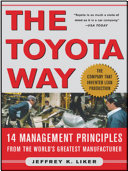

Continuous Improvement, or Kaizen, is a fundamental principle of the Toyota Production System (TPS) that emphasizes the need for ongoing, incremental improvements in processes, products, and services. This concept encourages every employee, from the top management to the assembly line workers, to seek ways to enhance their work, eliminate waste, and improve quality. The philosophy behind Kaizen is that small, consistent changes can lead to significant improvements over time. Toyota implements this by fostering a culture where employees are empowered to identify problems and suggest solutions. This not only leads to better efficiency but also enhances employee engagement and morale. The book illustrates numerous examples of how Kaizen has been applied at Toyota, showcasing its impact on productivity and quality. The idea is that improvement is a never-ending process, and organizations should always strive for higher standards and better performance.
Continue readingRespect for People is a core value at Toyota that emphasizes the importance of treating employees, suppliers, and customers with dignity and respect. This principle asserts that people are the most valuable asset of any organization, and their involvement is crucial for success. Toyota believes in building strong relationships with all stakeholders, creating a sense of community and teamwork. The book discusses how Toyota invests in its employees through training and development, ensuring they have the skills and knowledge necessary to contribute effectively. By fostering a culture of respect, Toyota encourages open communication and collaboration, which leads to innovative solutions and a more committed workforce. This principle also extends to suppliers, where Toyota seeks mutually beneficial relationships that enhance quality and efficiency across the supply chain.
Continue readingJust-In-Time (JIT) is a key component of the Toyota Production System that focuses on producing only what is needed, when it is needed, and in the amount needed. This approach minimizes inventory costs and reduces waste, as it eliminates the need for excess stock and storage. JIT requires precise coordination of production schedules, supply chain logistics, and demand forecasting. The book explains how Toyota implemented JIT to enhance its operational efficiency, streamline processes, and respond quickly to market changes. By synchronizing production with customer demand, Toyota can reduce lead times and improve product quality. JIT also promotes a culture of flexibility and adaptability, as it encourages teams to react promptly to fluctuations in demand.
Continue readingGenchi Genbutsu, or 'go and see,' is a principle that emphasizes the importance of firsthand observation in understanding problems and making decisions. Toyota encourages its leaders and employees to visit the shop floor, engage with processes, and observe operations in real-time. This hands-on approach helps identify inefficiencies, quality issues, and areas for improvement that may not be apparent through reports or data alone. The book illustrates how this principle fosters a culture of accountability, as leaders are expected to understand the realities of the workplace. By encouraging employees to investigate problems directly, Toyota cultivates a deeper understanding of the work environment and empowers teams to take ownership of their processes.
Continue readingThe elimination of waste, or Muda, is a central tenet of the Toyota Production System. Waste can take many forms, including excess inventory, overproduction, waiting times, unnecessary transportation, and defects. The book outlines the various types of waste and emphasizes the importance of identifying and eliminating them to improve efficiency and reduce costs. Toyota employs several tools and techniques, such as value stream mapping and 5S, to systematically identify waste in its processes. The philosophy behind Muda is that by minimizing waste, organizations can enhance value for customers and improve overall productivity. The book provides real-world examples of how Toyota has successfully reduced waste and the positive impact this has had on its operations.
Continue readingStandardized work is a method used by Toyota to ensure that processes are performed consistently and efficiently. This involves creating detailed documentation of best practices for each task, which serves as a baseline for performance. The book discusses how standardized work helps maintain quality, reduces variability, and enables continuous improvement. By establishing clear standards, Toyota can train new employees effectively, monitor performance, and identify areas for improvement. Standardized work also facilitates problem-solving, as deviations from the standard can be quickly identified and addressed. This principle is crucial for maintaining operational excellence and ensuring that all employees are aligned in their efforts to achieve the organization's goals.
Continue readingA long-term philosophy is essential for sustainable success, according to Toyota. The book emphasizes that decisions should be made with a long-term perspective rather than focusing solely on short-term profits. This principle encourages organizations to invest in their people, processes, and technology to build a strong foundation for future growth. Toyota's commitment to quality, innovation, and customer satisfaction is rooted in its long-term vision, which drives its strategic decisions. The book provides examples of how this philosophy has guided Toyota through challenges and helped it maintain its competitive edge. By prioritizing long-term goals, organizations can foster a culture of resilience and adaptability, ensuring they remain relevant in a rapidly changing market.
Continue reading